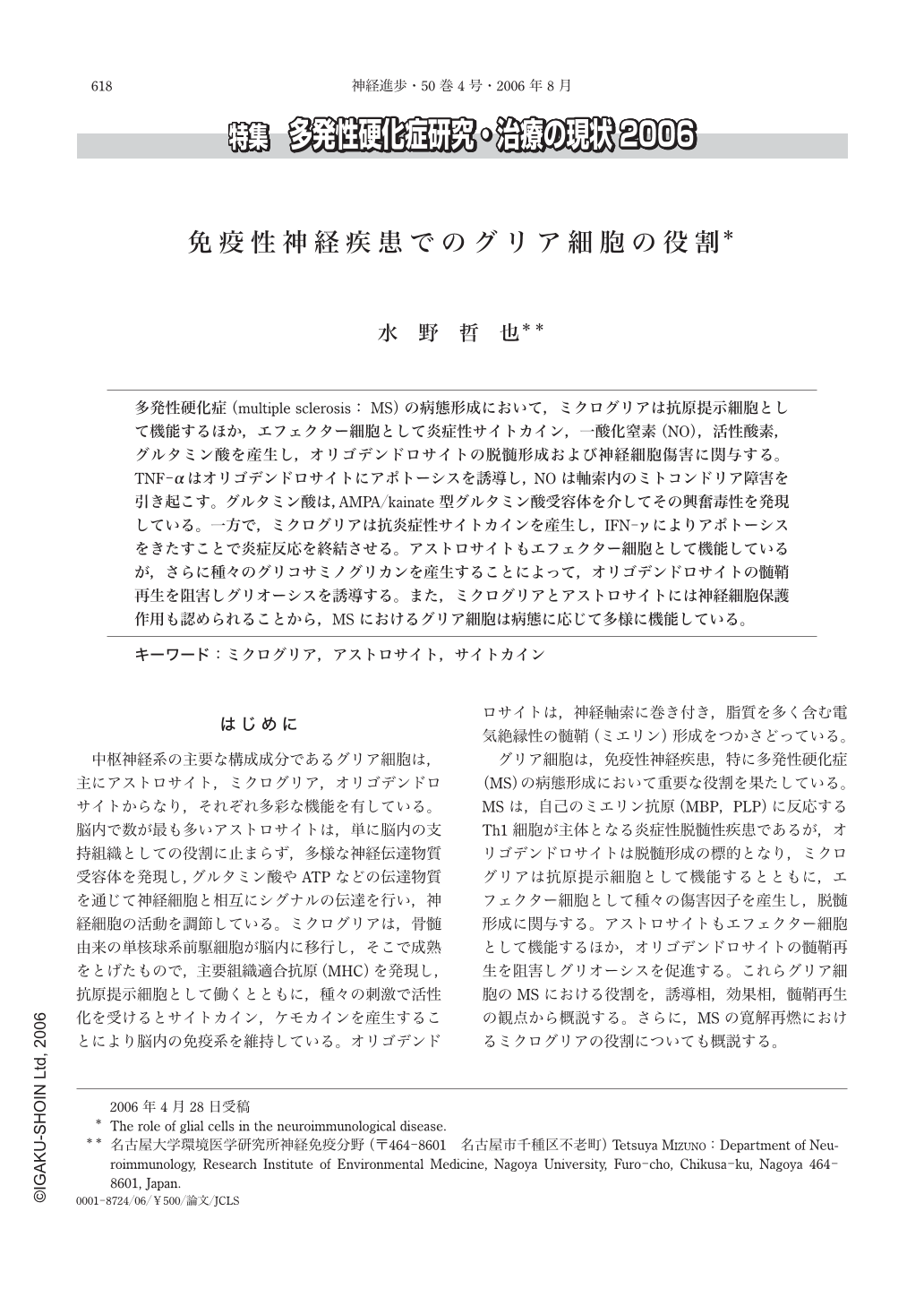Japanese
English
- 有料閲覧
- Abstract 文献概要
- 1ページ目 Look Inside
- 参考文献 Reference
多発性硬化症(multiple sclerosis: MS)の病態形成において,ミクログリアは抗原提示細胞として機能するほか,エフェクター細胞として炎症性サイトカイン,一酸化窒素(NO),活性酸素,グルタミン酸を産生し,オリゴデンドロサイトの脱髄形成および神経細胞傷害に関与する。TNF-αはオリゴデンドロサイトにアポトーシスを誘導し,NOは軸索内のミトコンドリア障害を引き起こす。グルタミン酸は,AMPA/kainate型グルタミン酸受容体を介してその興奮毒性を発現している。一方で,ミクログリアは抗炎症性サイトカインを産生し,IFN-γによりアポトーシスをきたすことで炎症反応を終結させる。アストロサイトもエフェクター細胞として機能しているが,さらに種々のグリコサミノグリカンを産生することによって,オリゴデンドロサイトの髄鞘再生を阻害しグリオーシスを誘導する。また,ミクログリアとアストロサイトには神経細胞保護作用も認められることから,MSにおけるグリア細胞は病態に応じて多様に機能している。
Glial cells have important roles in the pathogenesis of multiple sclerosis(MS)and its animal model, experimental autoimmune encephalomyelitis(EAE). Microglia function as antigen presenting cells in the induction phase of MS, and produce IL-12 family cytokines and IL-18, which regulate differentiation of naive T cells into T helper 1 cells. When activated by cytokines such as TNF-α and IFN-γ microglia function as effector cells and produce various inflammatory cytokines, nitric oxide(NO), reactive oxygen species and glutamate. These molecules are toxic to oligodendrocyte. TNF-α induces apoptosis of oligodendrocyte through TNF-α receptor 1. NO and superoxide form peroxynitrite, which is toxic to oligodendrocyte by lipid peroxidation. Glutamate excitotoxicity mediated by the AMPA type of glutamate receptor also damages oligodendrocyte. Axonal degeneration is a major cause of neurological deficit in MS. NO causes axons to degenerate by impairing mitochondrial metabolism and limit ATP production. Glutamate produced by activated microglia also damages neuronal cells via NMDA type of glutamate receptor. Because dendrites are vulnerable to excitotoxicity, dendritic beading, focal bead-like swellings in the dendrites, occurs in the white matter during acute EAE episodes and EAE relapses. It occurs concordant with a rapid drop in intracellular ATP levels and preceded neuronal death. Astrocytes produce a high molecular weight form of hyaluronan, which accumulates in chronic demyelinated lesions and inhibits oligodendrocyte progenitor maturation. Microglial apoptosis is observed in peak EAE mice, but not in early EAE. IFN-γ induces microglial apoptosis as the activation-induced cell death, which is associated with the up-regulation of pro-apoptosis proteins, especially Bax. INF-γ may act on microglia as part of a self-limiting negative feedback system. Microglia have a role in the suppression of EAE, by producing inhibitory cytokine, IL-10. Moreover microglia show a protective effect on NMDA neurotoxicity. Thus, to clarify the roles of glial cells in MS seems to be an important approach for a new therapy for MS.

Copyright © 2006, Igaku-Shoin Ltd. All rights reserved.


